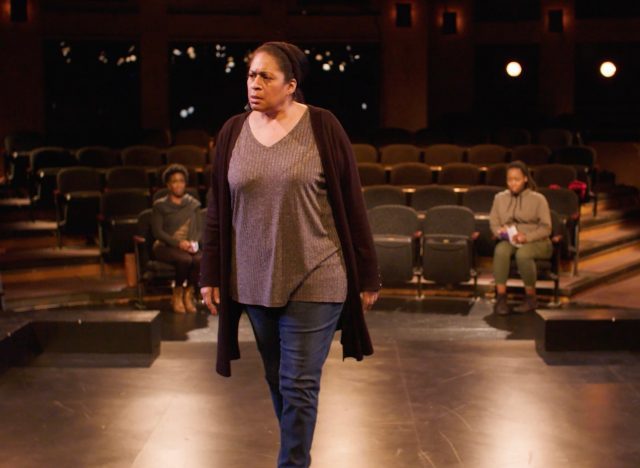
Until the Flood features three women playing multiple roles in dazzling production
Studio Theatre associate artistic director Reginald L. Douglas takes Dael Orlandersmith’s one-woman show, Until the Flood, to a whole new level in a stirring, deeply affecting online version, streaming through May 9. In January 2018, Pulitzer Prize finalist Orlandersmith presented Until the Flood at Rattlestick Playwrights Theater. In the play, which was originally commissioned by the Repertory Theatre of St. Louis, Orlandersmith portrays eight composite characters in relating the tragic story of the killing of Michael Brown at the hands of police officer Darren Wilson in Ferguson, Missouri, on August 9, 2014; Orlandersmith traveled to Ferguson and interviewed dozens of people to understand the incident from every possible angle. (A recording of the Rattlestick show can be viewed for free here.)
Douglas has transformed the work by having a trio of stunning Black women of different ages, Felicia Curry, Ora Jones, and Billie Krishawn, perform the roles of Black retired schoolteacher Louisa Hemphill (70s), white retired policeman Rusty Harden (75), Black teen Hassan (17), white high school teacher Connie Hamm (35), Black barber Reuben Little (late 60s/early 70s), white landowner and electrician Dougray Smith (late 30s/early 40s), Black high school student Paul (17), and Black Unitarian minister Edna Lewis (late 50s/early 60s), who share their thoughts on racism, anger, violence, poverty, fear, bigotry, liberalism, homosexuality, protest, privilege, education, and other social issues. There is almost too much pain to bear, but keep watching.
“It wasn’t until I reached my mid- to late-30s and moved back to St. Louis, and when both parents died, I realized, saw; and I remember my father saying how racism causes self-hate,” Hemphill (Jones) recalls. “Legacy is the word that comes to mind. Legacy. The legacy of self-hate. The legacy of keeping your place. The legacy of grinning and bowing. The legacy of seeing yourself as a n****r, being taught to see yourself as a n****r. My God, how I hate that word. How I hate when anybody, white or Black, uses it. That young man, Michael Brown, his death, he was made to see himself that way — as a n****r. As someone who was nondeserving. He was set up, and he set himself up to fail.”
Filmed using several cameras that follow the characters on Studio Theatre’s DC stage and in the empty seats, moving from close-ups to longer shots that remind us of the loneliness and isolation of the pandemic lockdown, the eighty-minute production might be specifically about Brown and Ferguson, but now, in 2021, it also evokes George Floyd and Minneapolis, Adam Toledo and Chicago, Breonna Taylor and Louisville, Daunte Wright and Brooklyn Center, Rayshard Brooks and Atlanta, Elijah McClain and Aurora, Philando Castile and Falcon Heights, Alton Sterling and Baton Rouge, Sandra Bland and Hempstead, Freddie Gray and Baltimore, Tamir Rice and Cleveland, and so many other men, women, and children of color killed by police around the country since Brown’s murder.

Dael Orlandersmith’s Until the Flood explores the Michael Brown shooting and more in blazing Studio Theatre adaptation
“There is a part of me that wants to go, get out. There’s a part that wants to stand before a gun, right in front of some redneck, hungry motherfucker who don’t know my name, who don’t care what my name is, but I know this motherfucker would aim to shoot and not miss,” Hassan (Krishawn), wearing a hoodie, shouts. “I’m seventeen, man. Sometimes I feel seven, sometimes I feel seventy, and I want out. Spill my blood, man, spill it. I just want out! Do it!”
Each scene seamlessly transitions to the next with the actresses, sometimes with script in hand, slightly overlapping in a kind of nonphysical handoff, acknowledging one another as one takes center stage and the other sits down, melding audience, performer, and character. (The expert lighting and sound are by Jesse Belsky and Elisheba Ittoop, respectively.) Douglas and video director Wes Culwell occasionally cut to the reactions of the other two while the third is delivering a monologue; in addition, the two seated actresses perform dialogue within the third’s speech when a character other than the one they are playing speaks.
Curry (Collective Rage: A Play in Five Boops, Bloody Bloody Andrew Jackson), Jones (Curve of Departure, The Children), and Krishawn (Blood at the Root, Ohio State Murders) are extraordinary, gaining power and passion as Orlandersmith, whose other works include Forever, Yellowman, Monster, and The Gimmick, digs deeper into the many aspects of racial injustice, as seen from multiple sides.
“I’m not gonna live in fear. I won’t give in to it,” Paul (Curry at her fiercest) declares before walking over to a concrete pillar, softly looking at it and touching it, then admitting, “I live in the Canfield apartments just like Michael Brown did. You know, if you look at a housing project or low-income apartments like Canfield, if you really look at it, it looks just like a prison. I mean, it really does look just like a prison. Sometimes it feels like that too. Feels just like a prison. There’s something that’s just, I don’t know, defeated there. It feels defeated.”
The finale is not about defeat, nearly exploding off the screen as Curry, Jones, and Krishawn unite, three generations coming together onstage while pointing to the future. Throughout the play, it becomes more and more apparent via costume changes that Krishawn is pregnant, and by the end, she is rubbing and holding her belly, hoping and praying, along with us, that her baby won’t become the next Michael Brown.